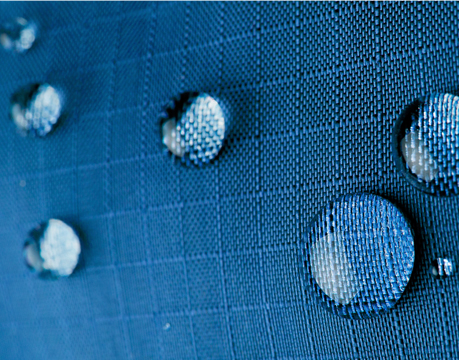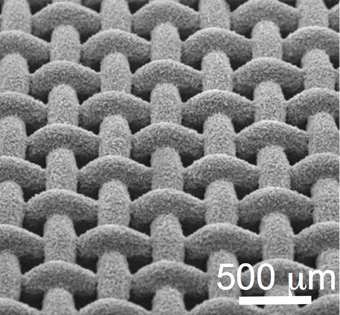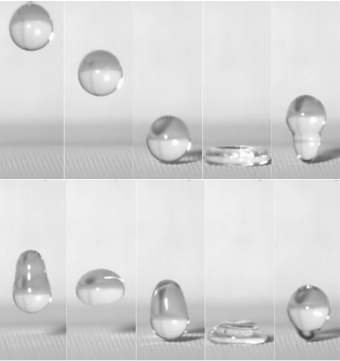
Staying dry is easy when water’s the only worry. Super hydrophobic surfaces crop up everywhere in nature. Thanks to a relatively high surface tension, water beads up and rolls right off broccoli, cabbage, euphorbia, duck feathers, butterfly wings, and mosquito legs. Humans, too, have managed to manufacture their own water-repellent materials.
But keeping dry when oil, alcohol, or other liquids are involved as well is a different story. These other liquids have a lower surface tension, which is why oil spreads on Teflon while water skits across it (in fact, in some cases, super hydrophobic surfaces are like sponges for other liquids, which is a why oil spills kill ducks).
 |
| Detail of the superomniphobic surface developed by Professor Anish Tuteja and his team that highlights the hierarchical texture present with the surface texture. Image: University of Michigan |
But now thanks to a new nano technique, researchers in the Department of Materials Science and Engineering at the University of Michigan have come up with a material that repels water, oil, alcohol, and just about any liquid under the sun.
“The key is, essentially, trapping as much air as you can underneath the liquid droplet,” says Anish Tuteja, an assistant professor at the University who spearheaded the project. Drops of liquid naturally turn spherical when unencumbered by surfaces. To keep them round and rolling off, a surface needs to be as un-surface-like as possible. “Imagine a net,” says Tuteja. “The openings are the air pockets, and if the liquid is the tennis ball, it can’t penetrate through it.”
Hierarchical Approach
Tuteja sought to make those openings as large as possible without letting the ball pass through, which, in the case of liquids, would mean wetting the surface. His fabric needed to “maximize the fraction of air, while maintaining enough breakthrough pressure.” The geometry of the fabric is “reentrant,” which is to say it bends back on itself, like a sphere. Tuteja showed, back in 2007, that such shapes cause low surface tension liquids to bead up. So the new textile has cylindrical fibers. |
A series of images illustrating droplets of acetic acid bouncing
on the hierarchically structured superomniphobic surface that is tilted
by 2° relative to the horizontal. Image: University of Michigan
|
To make it truly repellent to all liquids, Tuteja used a hierarchical approach. Onto the re-entrant mesh of suitable porosity, Tuteja sprayed a coating of tiny reentrant particles of suitable porosity. It’s just an “aggregate of spheres,” says Tuteja of the coating.
The result is a surface that keeps the fluids hopping—off.
Nearly all of them, that is. The “just about” in “just about any liquid under the sun,” found above, comes thanks to some chlorofluorocarbons of extremely low surface tension who had to spoil the party. Aside from them, every liquid Tuteja and his colleauges threw at the new surface bounced right off.
Potential Applications
One measure of how un-wetable a material is it’s surface energy. Teflon has a score of 17 millinewtons a meter. Tuteja’s new surface has a 10. That’s a good 60% to 70% lower than the famous non-stick stuff. And where Teflon is unwieldy to process—it’s hard and won’t dissolve into solvents—this slick new material is a breeze. It can be sprayed on and dissolves easily into several solvents. It’s toxicity, however, has yet to be tested.The potential applications are many, as evidenced by the slew of calls from industry Tuteja has received. These include textile manufacturers and shoe manufacturers looking to make their products stain free and engine manufacturers and people involved in wastewater treatment looking to avoid buildup. Ship builders, hoping to cut down on drag, want to cover their hulls in the stuff. Manufactures of smart phones and tablets see a way to keep their screens free of fingerprints and other smudge. Those who make sunglasses and goggles look forward to a future with fog and filth free lenses.
None of that is to say that Tuteja is in it for the money. “I’d like to see it get out there, whether I make five dollars or a thousand,” he says. “The fun part is doing the work.”


.jpg)

0 comments:
Post a Comment